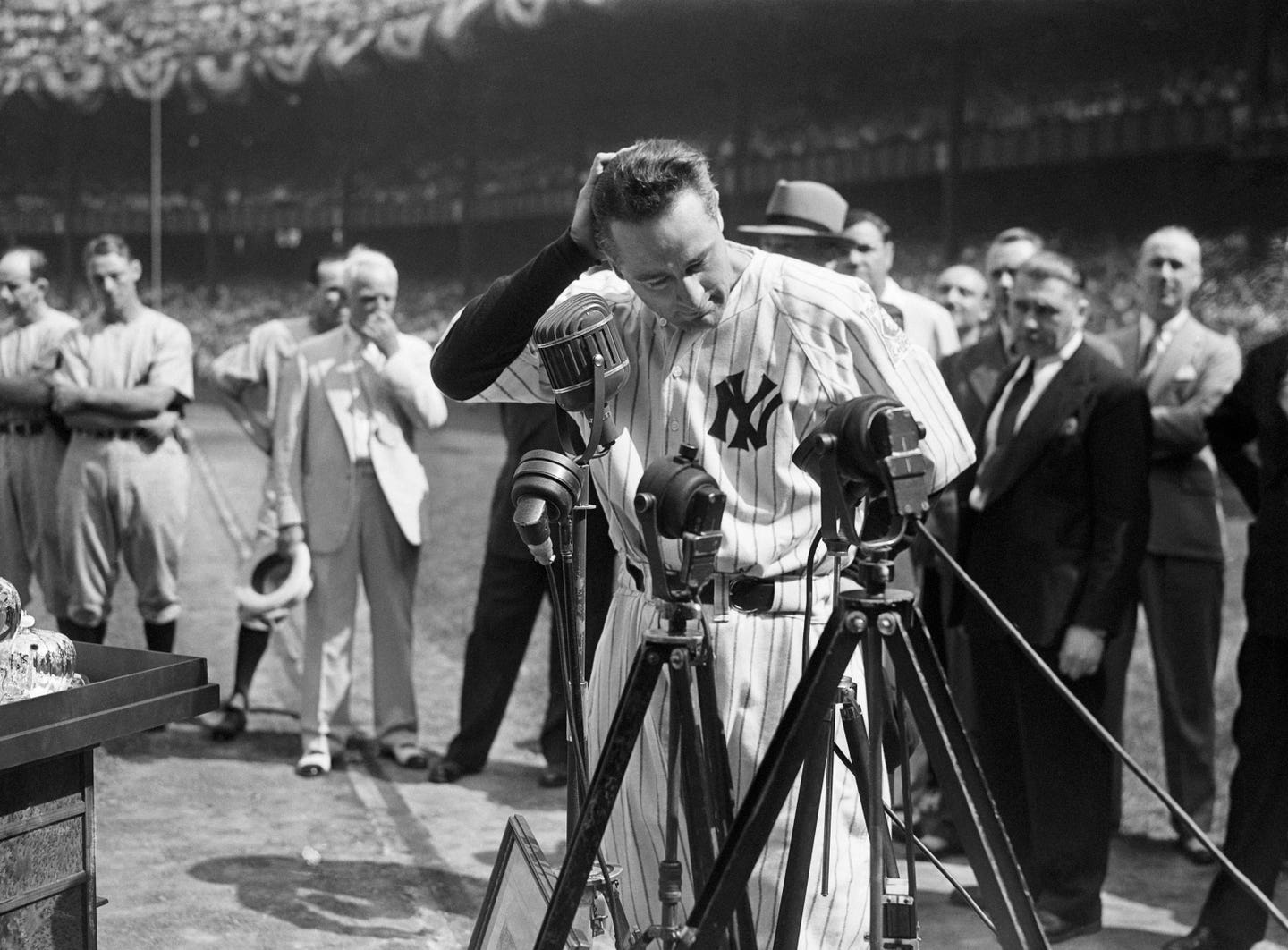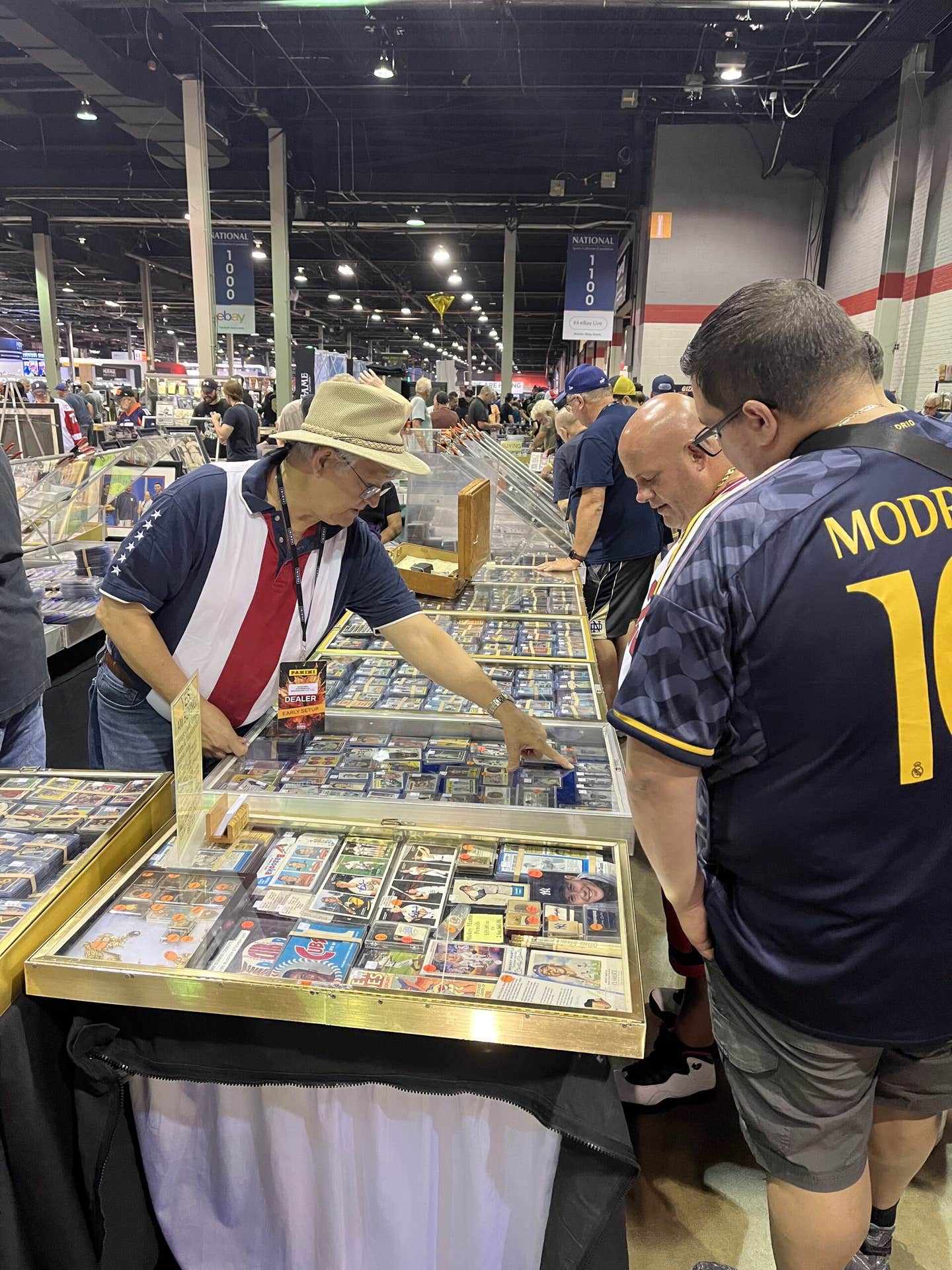
News
Lou Gehrig remains forever the ‘Luckiest Man on the face of the Earth’
Eight decades later his words endure and resonate. Lou Gehrig’s “Luckiest man on the face of the Earth” oratory is considered baseball’s “Gettsyburg Address.”
Though just 277 words long, it was so moving, so eloquent that noted wordsmith William Safire included it in a book about history’s greatest speeches, alongside those delivered by popes, presidents, kings, playwrights, civil rights activists and philosophers. That this once strapping, seemingly indestructible New York Yankees slugger was able to express optimism and gratitude in the face of death remains a transcendent, inspirational moment all these years later.
On a sweltering Independence Day at a packed Yankee Stadium in 1939, Gehrig stepped up to home plate and came through wielding a microphone rather than a Louisville Slugger. The renowned line-drive hitter delivered lines that have stood the test of time.
And this June 2 — and every June 2 to follow — the Bronx Bomber’s words will ring out again, in ballparks across America as Lou Gehrig joins Jackie Robinson (April 15) and Roberto Clemente (September 9) as the only players to be honored with annual days on the Major League Baseball calendar.
Players, managers and coaches will specially designed red patches and wristbands bearing Gehrig’s jersey No. 4, and ceremonies will be held in each major league park to commemorate Lou Gehrig Day. Fans will learn about the Hall of Fame first baseman’s remarkable baseball career, and about ALS (amyotrophic lateral sclerosis), the fatal neurodegenerative disease that came to bear his name.
MLB’s decision to celebrate Gehrig’s life and legacy on June 2 makes sense because that day marked both a beginning and an end. On that late spring afternoon in 1925, Gehrig officially replaced Wally Pipp in the Yankees’ lineup, launching the Iron Horse’s streak of 2,130 consecutive games. And sixteen years to the day later, Gehrig would die at age 37 of ALS, the incurable disorder that afflicts nearly 5,000 Americans annually, causing its victims to lose control of their muscles, affecting their ability to walk, talk, eat and breathe. MLB is hoping to use the day to raise awareness and research funds to find a cure.
The day was surely emotional for Oakland A’s outfielder Stephen Piscotty and Colorado Rockies outfielder Sam Hilliard, each of whom have been personally touched by the disease. Piscotty lost his mother to ALS in 2018, while Hilliard’s father contracted it that same year, and is now confined to a wheelchair.
Since Jim Hilliard’s diagnosis, Sam and his mom, Tamara, have made it their mission to fight ALS. Their quest led them to become part of the movement that helped Lou Gehrig Day become a reality. In the course of their networking, they were contacted by songwriter Bryan Wayne Galentine, who had been diagnosed with ALS in 2017. After meeting Tamara at an event in Nashville, and learning that her son was a professional baseball player, Galentine asked her if MLB might be interested in honoring Gehrig with a special day the way it did for Robinson and Clemente.
Tamara loved the idea, and soon she, her son and other members of the newly formed LG4Day committee were connecting with players and staff throughout MLB to build support for the cause. The idea was to garner as much grassroots interest as possible before approaching Commissioner Rob Manfred. The Rockies were the first organization to join the cause, in part because their vice president of community and retail sales, Jim Kellogg, had lost his mom to ALS. The movement eventually stalled a bit, but thanks to some late lobbying by team presidents Derrick Hall (Arizona Diamondbacks), Sam Kennedy (Boston Red Sox) and Dave St. Peter (Minnesota Twins), the committee got all 30 MLB teams on board by Oct. 20, 2020.
Two days later, Galentine died.
“Amazingly, I guess you could say, Bryan Wayne got to hear the news right before he passed away,’’ Tamara told the Denver Post. “So, this is so special for us. To see how Bryan Wayne grew this from such a small thing to this amazing day is hard to describe.”
GEHRIG’S GREATNESS
The top priority of Lou Gehrig Day will be to raise awareness and research dollars. But a nice off-shoot will be the attention it calls to Gehrig’s greatness as a ballplayer and a man. It’s interesting and somewhat sad that when debates rage about the greatest player of all-time, the Iron Horse’s name rarely surfaces. A closer look at his stats and achievements reveals he deserves to be in the discussion.
His final overall stats stack up quite favorably — a .340 batting average, 1,955 runs batted in, 493 homers, 534 doubles, 163 triples, a .632 slugging percentage, and an on-base/slugging percentage of 1.0798, which trails only all-time leader Babe Ruth and runner-up Ted Williams. No player in the game’s history has strung together a better 13-year stretch than Gehrig. From 1926-1938, he averaged 147 runs batted in, 36 homers, 139 runs scored, a .452 on-base percentage and a .640 slugging percentage. He drove in more than 100 runs and scored more than 100 runs in each of those seasons — a streak unequalled. Seven times during his big-league career, Gehrig drove in more than 150 runs in a season, more than any other player. Ruth did it five times. Hank Greenberg and Al Simmons did it three times. No other player has done it more than twice. His .92 RBIs per game is the best average for any player whose career began after 1900. And he was at his best in the post-season, batting .361 with 10 homers, 35 RBIs and an astounding OPS of 1.214.
And let’s not forget The Streak, a record that lasted 56 years before Cal Ripken broke it in the summer of 1995.
Gehrig’s phenomenal endurance mark actually began when he pinch-hit on June 1, 1925. Lore had it that Pipp suffered a debilitating headache after a batting practice beaning the next day, opening the door for the 23-year-old slugger from Columbia University to start at first base. Problem is the story isn’t true, even though the myth continues to be perpetuated all these decades later. Pipp didn’t suffer that beaning for another month. Gehrig started on June 2 because Yankees manager Miller Huggins wanted to shake up his slumping lineup. Larrupin’ Lou went 3-for-5 that afternoon, and the rest is history.
He wouldn’t come out of the lineup again until May 2, 1939 — at his own request — following a dreadful start that saw him hit just .143 with no extra base hits in eight games.
A SAD DAY
That something was seriously wrong became apparent during a spring training batting practice when Gehrig failed to put the bat on the ball for 19 consecutive pitches. There also would be incidents where he fell off his locker stool while attempting to put his uniform pants on. His body and motor skills were mysteriously betraying him.
Finally, on June 19 that year — his 36th birthday — Gehrig traveled to the Mayo Clinic in Minnesota, where he was diagnosed with ALS.
Realizing the severity and urgency of the situation, general manager Ed Barrow hastily arranged a Lou Gehrig Appreciation Day on the Fourth of July at the big ballpark in the Bronx. Between games of a doubleheader, a ceremony was held, attended by Mayor Fiorello La Guardia and former teammates such as Ruth, Pipp and Tony Lazzeri. Yankees manager Joe McCarthy recounted the day Gehrig begged out of the lineup.
“It was a sad day in the life of everybody who knew you when you came into my hotel room in Detroit and told me you were quitting as a ballplayer because you felt yourself a hindrance to the team. My God, man, you were never that.”
And then it was time for Gehrig to address the crowd of 61,808. Several seconds passed, then the anxious crowd began chanting, “We want Lou! We want Lou!” McCarthy went over and whispered something in Gehrig’s ear. The Iron Horse nodded, then stepped closer to the microphone. The chants ceased. The stadium became silent.
“Fans,’’ he began, his head bowed, his voice booming. “For the past two weeks you have been reading about the bad break I got. Yet today, I consider myself the luckiest man on the face of the earth.”
In his distinctive New York accent, he went on to cite all the things he was grateful for, starting with baseball and concluding with his parents, and his beloved wife, Eleanor.
“So, I close in saying that I may have been given a tough break, but I have an awful lot to live for.”
As the crowd roared, Ruth walked over to Gehrig and hugged him tightly. The Baseball Hall of Fame waived its eligibility requirements and the baseball writers voted to induct him immediately. The Yankees retired his jersey, making him the first athlete ever to be so honored. Less than two years later — just 17 days shy of his 38th birthday — Gehrig died.
A year later, he would be immortalized on the silver screen, with the release of the Samuel Goldwyn-produced film, “The Pride of the Yankees.” Gehrig was played by Hollywood heavy hitter Gary Cooper, who left much to be desired in the ball-playing scenes but was convincing when it came time to reenact the ballplayer’s farewell speech.
Over time, ALS came to be known as “Lou Gehrig’s Disease.’’
And this June 2 — and for every June 2 to follow — the courage he displayed while combatting it will be celebrated, and funds will be raised in hopes that one day the disease will be eradicated.
— Nationally honored journalist Scott Pitoniak is the author of more than 25 books, including the recently published “Remembrances of Swings Past: A Lifetime of Baseball Stories,’’ available in paperback and Kindle at amazon.com.








